Main content starts here.
Foreign Languages > Chiba International Information Square - To foreign residents - > Chiba Nanohana News > Chiba Nanohana News (Past Issues) > Chiba Nanohana News (March 2020)
Update: March 14, 2023
Chiba Nanohana News (March 2020)
Index
I.News II . Festivals and Events
I.News
1) About the New Coronavirus
What is the New Coronavirus?
It is a type of virus that is characterized by fever, throat pain, a long period of coughing (around 1 week), and strong lethargy.
The time until onset from infection can take from 1 to 12.5 days (generally 5 to 6 days).
Things to Consider Before Consultation or Visiting Medical Institution
- Take off from work and school and avoid going out if signs of the virus, such as fever, appear
- Record your body temperature daily if signs of the virus, such as fever, appear
Coronavirus Consultation
Please call a Consultation Center for Persons Returning to Japan/Those With Contact with Infected if any of the below apply to you.
- If symptoms of the virus such as a fever of 37.5℃or more continue for four days or longer including those taking fever lowering medication.
- If you feel strong lethargy or struggle to breathe
Telephone Consultation for Information Regarding the Coronavirus
Telephone Consultation (Call Center)(Japanese only)
https://www.pref.chiba.lg.jp/kenfuku/kansenshou/corona-soudan.html
Persons Returning to Japan/Those With Contact with Infected(Japanese only)
https://www.pref.chiba.lg.jp/kenfuku/kansenshou/singata-korona-soudan.html
Japan Visitor Hotline( External link )
http://www.mlit.go.jp/kankocho/news08_000311.html( External link )
The Japan National Tourism Organization (JNTO) operates a visitor hotline 24 hours a day, 365 days a year. Support is available in English, Chinese, and Korean.
TEL:050-3816-2787
About the New Coronavirus
https://www.pref.chiba.lg.jp/kokusai/english/information/residents/newcoronavirus.html
2) Disaster Preparedness
March 11th 2011 marks one of the largest natural disasters in modern Japanese history. The Great East Japan earthquake caused enormous Damage and confusion throughout the country.
Chiba Prefecture provides disaster related information through the website “Chiba Prefecture Disaster Prevention Portal”. Some pages are available in Japanese, English, Korean, Chinese, Spanish, and Portuguese.
http://www.bousai.pref.chiba.lg.jp/( External link )
■ Earthquakes
Japan is one of the most earthquake-prone countries in the world. The following types of daily preparations are necessary to limit the damages caused by earthquakes.
- Home safety inspection
- Inspect and reinforce your building.
- Have sufficient water and food on hand.
- Have at least three days’ worth of preserved or mineral water ready.
- Prepare an emergency survival kit
- Prepare flashlights and portable radios, which are essential items for evacuation and gathering information.
- Family meetings
- Confirm what to do if an earthquake occurs, who will do what, and how to get in contact with each other. Confirm shelters and routes in the event that you need to evacuate your home.
■ Tsunami
Because Chiba Prefecture has a long coastline and is enclosed on three sides by the sea, damage from a tsunami in the event of an earthquake is a major concern.
When you have felt a strong earthquake or a weak earthquake but slow tremors for an extended period of time, leave the coast beach immediately, move to higher ground and quickly take shelter in a safe location.
Because tsunamis strike repeatedly in a series of waves, do not relax your vigilance until the tsunami warning or advisory has been lifted.
■ Typhoons
Depending on the typhoon’s route, rain and wind can cause more damage than one might expect, so it’s important to listen to weather information and take sufficient counter-measures.
- To prepare for power outages, make sure to have flashlights and handheld radios.
- There is a chance that water outages may occur, so ensure that you have drinking water.
- Pay attention to evacuation information released by your municipality, and be ready to evacuate as quickly as possible. Habitually confirm shelters and evacuation routes.
3) Prefecture E-Mail Magazine Reader Survey
Chiba Prefecture will hold a survey for readers of its e-mail magazine. Survey time period: Ongoing- March 20 (Friday, Holiday)
Please let us know your opinions of the e-mail magazine through the link below.
https://www.shinsei.elg-front.jp/chiba2/uketsuke/dform.do?acs=000mail2020EG
Inquiries: Chiba Prefecture E-mail Magazine Manager (Press and Public Relations Division)
II. Festivals and Events
1) Top 10 Rock Layers in Chiba
The Chibanian is an age in the geologic timescale. It has been selected as an age name for the first time in Japan and named after Chiba Prefecture in January 17, 2020.
The top 10 strata in Chiba Prefecture were selected to commemorate this achievement and further increase interest in the earth and geosciences. These 10 strata were selected based on their accessibility, variety of the geologic age from old time to modern, and special aspects of each stratum.
You are sure to be able to feel the formation of Chiba’s earth at these sites.
1. Kioroshi Shell Beds (Inzai City)
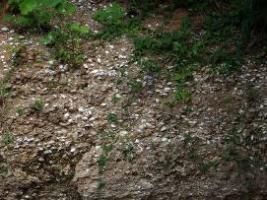
Shells that lived in Paleo-Tokyo Bay around 120,000 years ago can be found here.
- Location: Kioroshi, Inzai City
- Access: 10 minutes on foot from JR Kioroshi Station
2. Choshi Cretaceous Shallow Marine Deposits (Choshi City)
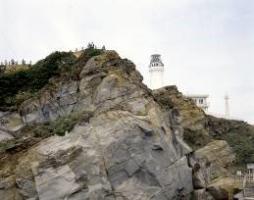
Strata formed by the stormy shallow-marine environment of 120 million years ago during the dinosaur era.
- Location: Inubosaki, Choshi City
- Access: 10 minutes on foot from the Choshi Electric Railway Inubosaki Station
3. Byobugaura (Asahi City, Choshi City)
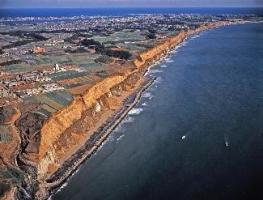
A long seaside cliff, called the “Dover of the East”, composed of the strata formed around 3 million to 100,000 years ago
- Location: Asahi City, Choshi City
- Access: Bus from JR Asahi or Choshi Station
4. The Strata which record Geomagnetic Reversal at Tabuchi along the Yorogawa River (Ichihara City)
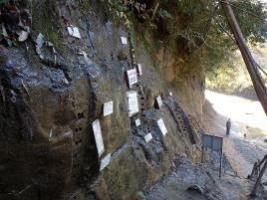
The strata that indicate the beginning of the Chibanian Age formed around 770,000 years ago.
- Location: Tabuchi, Ichihara City
- Access: 25 minutes on foot from the Kominato Railway Tsukizaki Station
5. The Alternating beds of Sandstone and Mudstone in the Kazusa Hill (Isumi City)
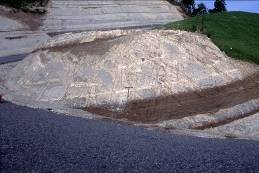
Strata formed by turbidity current flow in the deep sea around 1 million years ago.
- Location: Forest of Culture and Sports, Isumi City
- Access: 25 minutes on foot from the Isumi Railway Kuniyoshi Station
6. The Building Stone “Boshu-ishi” at Mt. Nokogiriyama (Futtsu City)
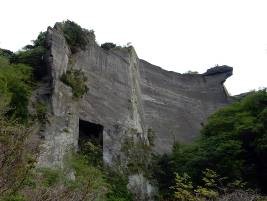
The building stones that helped the modernization of the Meiji Era. Formed around 2 million years ago.
- Location: Nokogiriyama, Futtsu City
- Access: Ropeway from the JR Hamakanaya Station
7. Katsuura Ubara Kurotaki Discordance (Katsuura City)
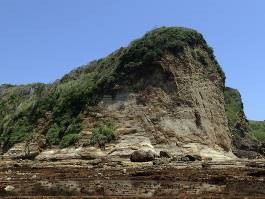
A big time gap within the strata formed around 2,500,000 years ago.
- Location: Yoshio, Katsuura City
- Access: 20 minutes on foot from JR Ubara Station
8. Kamogawa Matsushima (Kamogawa City)
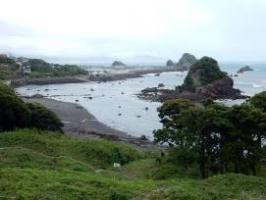
Strange islands formed by a wide variety of rocks. The rocks were formed around 40 million years ago.
- Location: Kaisuka, Kamogawa City
- Access: 20 minutes on foot from JR Futomi Station
9. The Chaotic Rock Strata of the Hota Group (Kamogawa City)

A chaotic strata formed by the subducting of oceanic plates around 18 million years ago
- Location: Emi, Kamogawa City
- Access: 20 minutes on foot from JR Emi Station
10. Numa Coral Beds (Tateyama City)
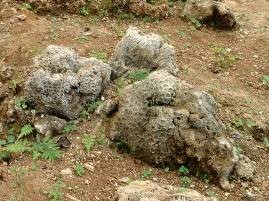
Strata containing fossil corals deposited under warm sea environments in the Jomon Period formed around 7,000 years ago.
- Location: Numa, Tateyama City
- Bus from JR Tateyama Station in the direction of Tateyama Kokutai, getting off at Nishinohamakaigan dori stop and 15 minutes on foot.
11. Shirahama Submarine Landslide Sediments (Minamiboso City)
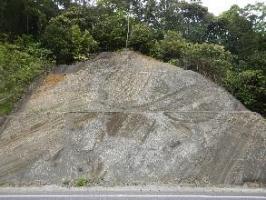
Strata formed by a submarine landslide around 2 million years ago.
- Location: Shirahama, Shirahama-cho, Minamiboso City
- Access: By car on the Awa Green Line, exiting off of the Awa Shirahama Tunnel North Exit (parking available)
2) Cherry Blossom Viewing Spots in Chiba
This is a list of the main cherry blossom viewing spots in Chiba.
The best dates to view the flowers are an estimation. Please check before going out.
※ Events such as Sakura Festivals may be canceled due to the spread of New Coronavirus.
Shimizu Park (Noda City)
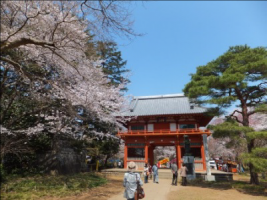
This park was selected as one of the top 100 cherry blossom viewing spots in Japan. You will be able to view cherry blossoms aged over 100 years. There will be a Cherry Blossom Festival held between March 20 and April 5.
- When to go: Early April
- Number of trees: Around 2,000
- Location: 906 Shimizu, Noda City
- Access: 5 minutes on foot from the west exit of Tobu Urban Park Line Shimizukoen Station
- Inquiries: TEL: 04-7125-3030 Shimizu Park Management Office
Omigawajoyama Park (Katori City)
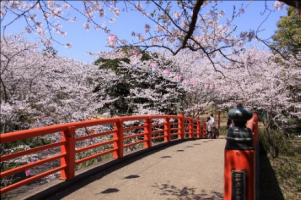
At the “Suigo Omigawa Cherry blossom and Azalea Festival” held from late March to mid-May, it will be especially worth seeing the lit-up cherry blossoms in full bloom held from 18:00 - 22:00 until mid-April.
- When to go: Early April
- Number of trees: Around 1,000
- Location: 431 Omigawa, Katori City
- Access: 20 minutes on foot from the JR Narita Line Omigawa Station
- Inquiries: TEL: 0478-50-1212 Suigo Omigawa Tourism Association
Mobara Park (Mobara City)
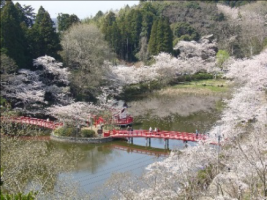 One of the top 100 Cherry Blossom viewing spots in Japan, light-up nightly from 18:00 - 5:00
One of the top 100 Cherry Blossom viewing spots in Japan, light-up nightly from 18:00 - 5:00
- When to go: Late March - early April
- Number of trees: Around 2,850
- Location: 1325-1 Takashi, Mobara City
- Access: From Mobara Station (JR Sotobo Line), take the bus bound for Chonan and get off at “Sogenji Temple” and 5 minutes on foot
- Inquiries: TEL: 0475-36-7595 Mobara City Tourism Association
Shiroyama Park (Tateyama City)
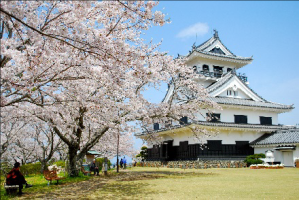
Located in the southern hilly area of the city, this park holds the castle of one of the Daimyo of the Sengoku Period, the Satomi clan. There is also a museum located at the top of the castle, where you can experience a spectacular view of the whole city.
- When to go: Late February - Late April
- Number of trees: Around 500
- Location: 362 Tateyama, Tateyama City
- Access: JR Bus in the Sunosaki direction or Nitto Bus in the Tateyama Air Base direction JR Uchibo Line Tateyama Station getting off at the Shiroyama Koenmae stop.
- Inquiries: TEL: 0470-22-3610 Tateyama City Urban Planning Division
Odayama Park (Kisarazu City)
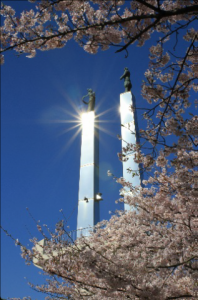
Cherry trees will be lit up from late March to early April, and you will be able to see the night views from the Kimisarazu Tower located in the park. You can see views of the Aqualine, Yokohama, and even Tokyo Skytree on clear days.
- When to go: Late March - Early April
- Number of trees: Around 400
- Location: 2-16 Oda, Kisarazu City
- Access: From the JR Uchibo Line Kisarazu Station East Exit, take the bus for 4 minutes, get off at Koi-no-mori stop and 5 minutes on foot.
- Inquiries: TEL:0438-22-7711 Kisarazu City Tourism Association
3) Cycling Courses in Chiba Prefecture
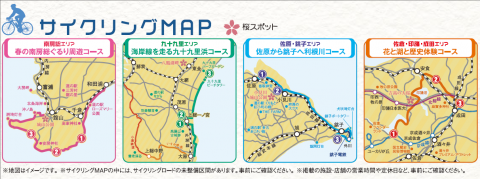
*There are parts of the courses without bike paths. Make sure you are aware where you can ride before heading out. Be sure to also double check the opening times, closed days etc. of establishments along the cycling course.
The sunny, warm spring is the perfect season for cycling. Let’s ride through the Boso Peninsula! This article will showcase recommended cycling courses.
Minamiboso Area
Spring Minamiboso Riding Course:Wadaura-Chikura-Shirahama-Tateyama
- Distance: 53.5 km
- Estimated time to complete: Around 3 and a half hours
- Highest elevation difference: 31m
Recommended Spots along the Course
1. Roadside Station Chikura Seabreeze Kingdom
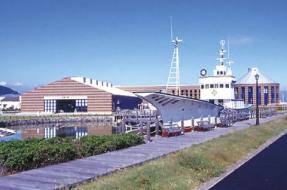
You can enjoy the fresh fruits of the sea at this roadside station. The fishing boats and wide lawn are the course landmarks. The nearby flower fields are also in bloom until late March.
- Inquiries: TEL:0470-43-1811
- Location: 1051 Senda, Chikura-cho, Minamiboso City
2. Cape Nojima
You can see the vast Pacific Ocean from this viewpoint. The sunset from the lover’s bench and walks around the lighthouse are recommended.
- Inquiries:TEL:0470-38-3231
- Location: 630 Shirahama, Shirahama-cho, Minamiboso City
3. Aloha Garden Tateyama
There are many things to here, all the way from enjoying hula dances and Hawaiian food, to interacting with animals and seeing rare plants.
- Inquiries:TEL:0470-28-1511
- Location: 1497 Fujiwara, Tateyama City
Kujukuri Area
Kujukuri Course along the Coast:Ohara-Ichinomiya-Shirasato-Kujukuri
- Distance: 38.5km
- Estimated time to complete: 2 hours 35 min
- Highest elevation difference: 17m
Recommended Spots along the Course
1. Kazusa Ichinomiya Tourist Information Center
You will be able to rent bicycles and surfboards as well as participate in trial surfing experiences. You can also buy gifts at the facility.
- Inquiries:TEL:0475-47-2100
- Location: 2738-1 Ichinomiya, Ichinomiya Town
2. Tamasaki Shrine
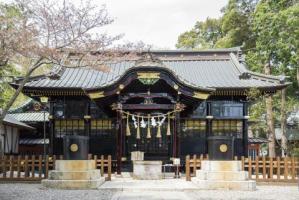
You can pray for marriage or safe childbirth at Tamasaki Shrine, which, according to feng shui, is located at the most favorable location respective to Tokyo. Because of this, many worshippers go here seeking good fortune.
- Inquiries:TEL:0475-42-2711
- Location: 3048 Ichinomiya, Ichinomiya Town
3. Seaside Station Kujukuri
There is a shop on the first floor, and you can enjoy clam ramen, sardines, and other Kujukuri delicacies at the food court on the second floor.
- Inquiries:TEL:0475-76-1734
- Location: 2347-98 Koseki, Kujukuri Town
Sawara/Choshi Area
Tone River Course from Sawara to Choshi:Sawara-Omigawa-Tonosho-Choshi
- Distance: 64.7km
- Estimated time to complete: 4 hours 20 min
- Highest elevation difference: 56m
Recommended Spots along the Course
1. Roadside/Riverside Station Mizunosato Sawara
Along with local specialties and rental bicycles, you will also be able to enjoy pleasure cruises on the Tone River, observe marine birds, and enjoy other marine leisure.
- Inquiries:TEL:0478-52-1138
- Location: 3981-2 I, Sawara, Katori City
2. Omigawajoyama Park
This park is a famous location to view cherry blossoms and azaleas which will be in full bloom from early April to early May. A light-up event will also be held.
- Inquiries:Katori City Urban Maintenance Division TEL:0478-50-1232
- Location: 431 Omigawa, Katori City
3. Byobugaura/Choshi Geo Park

Byobugaura is 50m tall cliff which extends for 10 km from Choshi to Cape Gyobu.Dubbed “The Dover of the East”, this is the most famous attraction at the Choshi Geo Park, where you can also study the Earth’s activities through the rock face.
- Inquiries:Choshi Geo Park Promotion Council TEL:0479-21-6667
※The easternmost point in the Kanto region, the Inubosaki Lighthouse, is also worth visiting.
Sakura/Inba/Narita Area
Flowers, Lakes, History Experience Course:Sakura-Inbanuma-Ajiki-Narita
- Distance: 27.1km
- Estimated time to complete: 1 hour 50 min
- Highest elevation difference: 28m
Recommended Spots along the Course
1. Sakura Hometown Square
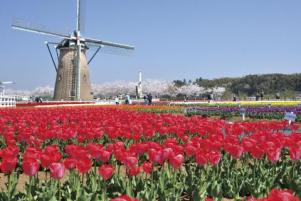
800,000 tulips will be in bloom with Dutch windmills and Inbanuma as the backdrop at the Sakura Tulip Festa held in Mid-April.
- Inquiries: Sakura City Tourism Association TEL:043-486-6000
- Location: 2714 Usuida, Sakura City
2. Chiba Prefectural Boso-no-Mura
An open air museum where you can learn about and experience Boso’s traditional lifestyle and technology all while having fun. There are over 400 types of performances and experiences held throughout the year.
- Inquiries:TEL:0476-95-3333
- Location: 1028 Ryukakuji, Sakae Town
3. Narita-san Omotesando/Eel Dining
Come enjoy eel at the Edo-esque Naritasan Shinshoji Temple Omotesando, which worshippers are said to have eaten during the Edo period as well. Other Narita specialties are also available.
- Inquiries:Narita City Tourism Association TEL:0476-22-2102
HOME Back to top I.News II.Festivals and Events
